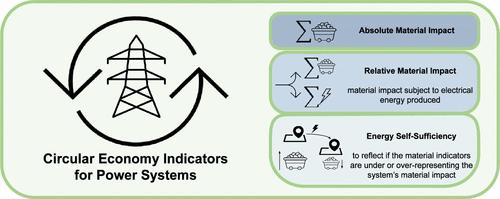超越减排:电力行业能源转型的循环经济指标
IF 3.9
3区 工程技术
Q2 ENGINEERING, CHEMICAL
引用次数: 0
摘要
能源转型使我们的社会从化石燃料转向可再生能源。然而,这种变化通过资源枯竭和废物积累对地球产生影响,最终危及转型的成功。可再生能源份额和排放强度等指标并不能代表这些对全球材料可用性的影响。本文提出了一套新的三个面向电力系统的循环经济指标,以补充当前的决策过程。这些指标是(i)相对物质影响,(ii)绝对物质影响,以及(iii)能源自给自足。这些指标提供了基于环保标准定义的操作标准,代表了资源自给自足和绝对物质影响等通常被忽视的概念。通过将这些指标应用于智利塔拉帕ac本文章由计算机程序翻译,如有差异,请以英文原文为准。

Beyond Emission Reductions: Circular Economy Indicators for the Energy Transition of the Power Sector
The energy transition moves our society from fossil fuels to renewable energy. However, the change impacts the planet through resource depletion and waste accumulation, ultimately risking the transition’s success. Indicators such as renewables share and emission intensity do not represent these impacts on global material availability. This paper proposes a novel set of three circular economy (CE) indicators oriented toward power systems to complement the current decision-making processes. These indicators are (i) relative material impact, (ii) absolute material impact, and (iii) energy self-sufficiency. These indicators provide operative criteria based on a CE definition, representing commonly overlooked concepts such as resource self-sufficiency and absolute material impacts. The effectiveness of these indicators in discriminating among different energy development plans is shown by applying them to a case study in the Tarapacá region, Chile. The proposed indicators integrate resilience to power systems planning by incorporating the material dimension. The notion of limit is deemed critical when designing a power system from a circular economy perspective and is structurally considered in the definition of the proposed indicators.
求助全文
通过发布文献求助,成功后即可免费获取论文全文。
去求助
来源期刊

Industrial & Engineering Chemistry Research
工程技术-工程:化工
CiteScore
7.40
自引率
7.10%
发文量
1467
审稿时长
2.8 months
期刊介绍:
ndustrial & Engineering Chemistry, with variations in title and format, has been published since 1909 by the American Chemical Society. Industrial & Engineering Chemistry Research is a weekly publication that reports industrial and academic research in the broad fields of applied chemistry and chemical engineering with special focus on fundamentals, processes, and products.
 求助内容:
求助内容: 应助结果提醒方式:
应助结果提醒方式:


